Day 4: Attapeu to Tat Lo
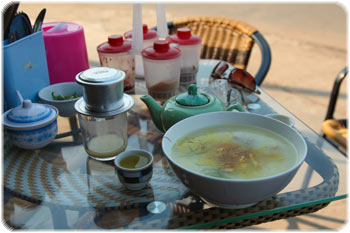
Vietnamese breakfast of ‘Cháo’ – rice soup with chicken (I think) and coffee!
We knew we had a long ride ahead of us today as we planned to backtrack all the way to Tat Lo, probably the longest leg of our journey on the Bolaven Plateau. So that meant an early start! We rode out to the main market in Attapeu fist thing to grab some baguettes and rambutans, much to the amusement of the locals who looked like they’d never seen a falang before!
I grabbed a quick typical Vietnamese breakfast of ‘Cháo’, a hearty mix of rice and chicken and a cheeky Vietnamese Ca Phe Sua Nong (strong short Vietnamese coffee with a slug of condensed milk!) and a complimentary pot of tea to kick start the day. Instantly needing a wee, we set off back towards Sekong just before 9:30am, still relatively cool and clear – perfect riding conditions!
It was good to take in the sights and ride a bit slower today as we were racing against the clock on our way to Attepeu. The road between Attapeu and Sekong is stunning. We passed rivers and streams, countless banana groves, and even more stilted shacks with smiling faces waving back at us.
Creatures of habit, we couldn’t help but stop in Sekong for another refreshing sugar cane juice and catch up with our new parrot friend and a rest-bite from the ever-rising sun.

Bad roads in the Sekong area
Just outside Sekong we hit some road maintainance and loads of loose gravel and shingles which slowed us down a bit.

Exploring villages away from the main road
We ventured from the main road, 1. To explore some of the villages away from the road and 2. For a wee. Now these villages were truly off the beaten track. We were a hit with the locals and some of the children seemed to be quite fascinated with my blonde arm hair!
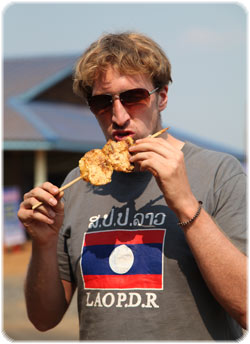
Barbecued bananas
We pushed on another 50km or so to Tha Taeng for some lunch, an arse break and some barbecued bananas on sticks! Tha Taeng is up at about 900m so it’s a lot cooler than sweat box Sekong and Attapeu, and it’s a perfect lunch spot before heading north to Tat Lo or back south to Paksong.
Our GT Rider map said the road north to Beng and Tat Lo was unsealed. Preparing for another bumpy ride we were glad to find that it’s recently been tarmacked all the way to Beng. This 20km stretch was probably the most beautiful we’d seen on the Bolaven Plateau, with glorious mountain views over rice paddies, rickety farmer houses and piles and piles of coffee berries drying in the sun.
We got a bit lost on the way to Tat Lo and almost stayed in the wrong village completely! But we got there eventually before dark, checked into Sipaseth Guesthouse overlooking the Tat Hang waterfall (quite expensive at 80,000 Kip, hot water), grabbed some Beer Lao’s and watched the sunset by the river.
Day 5 and 6: Chilling in Tat Lo
Check out Tat Lo, Laos: Waterfalls, Village Trekking and Hammocks! written during our 3 day arse resting Tat Lo chill-out.
Day 7: Tad Lo to Pakse
With our Laos visa running out and our flights to Thailand booked back to Chiang Mai, we begrudgingly packed up and set off from Tat Lo back to Pakse. In Tat Lo we picked up a leaflet about a Katu Textile Village, and decided to head there when we came off the plateau on the way back to Pakse. We saw signs for ‘FRESH GROUND COFFEE’ a few kilometres away from the village and pulled in. It would be rude not to!
We were pleasantly surprised to find out that as well as producing amazing textiles, they also produce their own home-grown coffee. And we arrived just as Mr Vieng and his wife were about to start roasting some beans!
This is a process we missed out on during our tour with Koffie, and something I had no idea about previously. First we pounded the beans in a huge pestle and mortar that Mr Vieng had made, removing the fine skin from the beans. It’s much harder than it looks, the wooden pounder was pretty heavy! Mr Vieng seemed amused with our lack of output, and quickly took over!

Dried beans ready for roasting
Then the skins and beans had to be separated. Using a woven sort of tray that I’ve seen used before for separating rice from its husk. Mr Vieng’s wife expertly separated the two. The beans had been drying out for 10 days beforehand to totally remove any moister from the coffee beans.
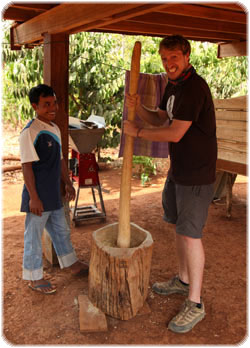
At least I gave it a try.
Once we had enough to roast, the trusty coffee roasting wok was produced and placed on the hot coals ready for the beans. Mr Vieng uses absolutely nothing during the roasting process, but he said that other coffee bean growers use sugar or oil to help ‘bulk out’ the beans and bring up the overall weight for more profit. Ultimately meaning lower quality coffee.
When the pan was ready, in went the beans and he began stirring like crazy. Once you put the beans on the heat, you can’t stop until they’re roasted. 15 minutes vigorous stirring later (you should see the size of his forearms), smoke was beginning to rise from the pan and the beans were looking very dark. He took the beans off the heat and poured them back into the woven tray and his wife tossed them again, separating burnt and excess coffee particles from the sweet smelling beans once more.
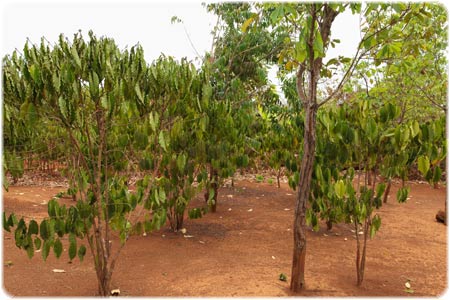
‘Robusta’ trees
The final process was to pick out the burnt beans by hand and allow to cool. Mr Vieng said he roasts 5-6 Kg of beans per day. He can sell each kilo bag for 25,000 Kip (£1.95), but experiences 10-30% loss in weight from the start process due to burnt beans and loss of moisture and skins. No wonder people add other ingredients to the mix!
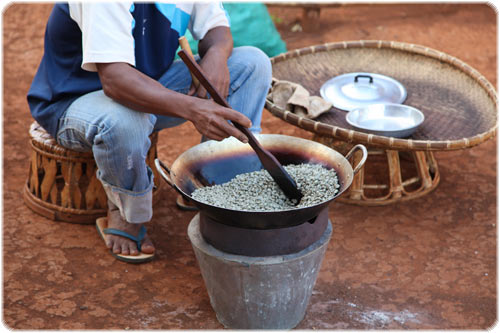
Roasting!
To put it in perspective, he said there are 40 cups of coffee per kilo. He said the real profit is the per cup price he sells for 10,000 Kip (80p) to tourists. And I can tell you that first sip of fresh ground and roasted robusta coffee hand-picked from his garden is well worth the 10,000 Kip! So think about the profits that are being made at Starbucks when your sipping on your next latte!
It was truly an eye opening experience seeing the process from berry, to bean, to cup. A very labour intensive process, with little profits for the makers and growers of the Bolaven Plateau’s independent coffee producers.
There’s also the opportunity for a home-stay with Mr Vieng and his wife in their beautiful home, surrounded by lush Robusta trees – Something we would have done if we had time on our Lao visa.

The final stretch into Pakse as the sun was coming down
Buzzing, we set off for the final 60 km back to Pakse. We wish we didn’t have to leave the Bolaven Plateau as it was probably our best Lao experience yet. We could have easily gone further round past Attapeu towards the Vietnamese frontier, and even headed north towards Salavan, spent more time in Tat Lo…
But there’s always next time! 😉
So there it is! A pretty huge article, probably our biggest. I hope you’re still awake and reading this! I hope you enjoyed it as much as we did!








Comments are closed.